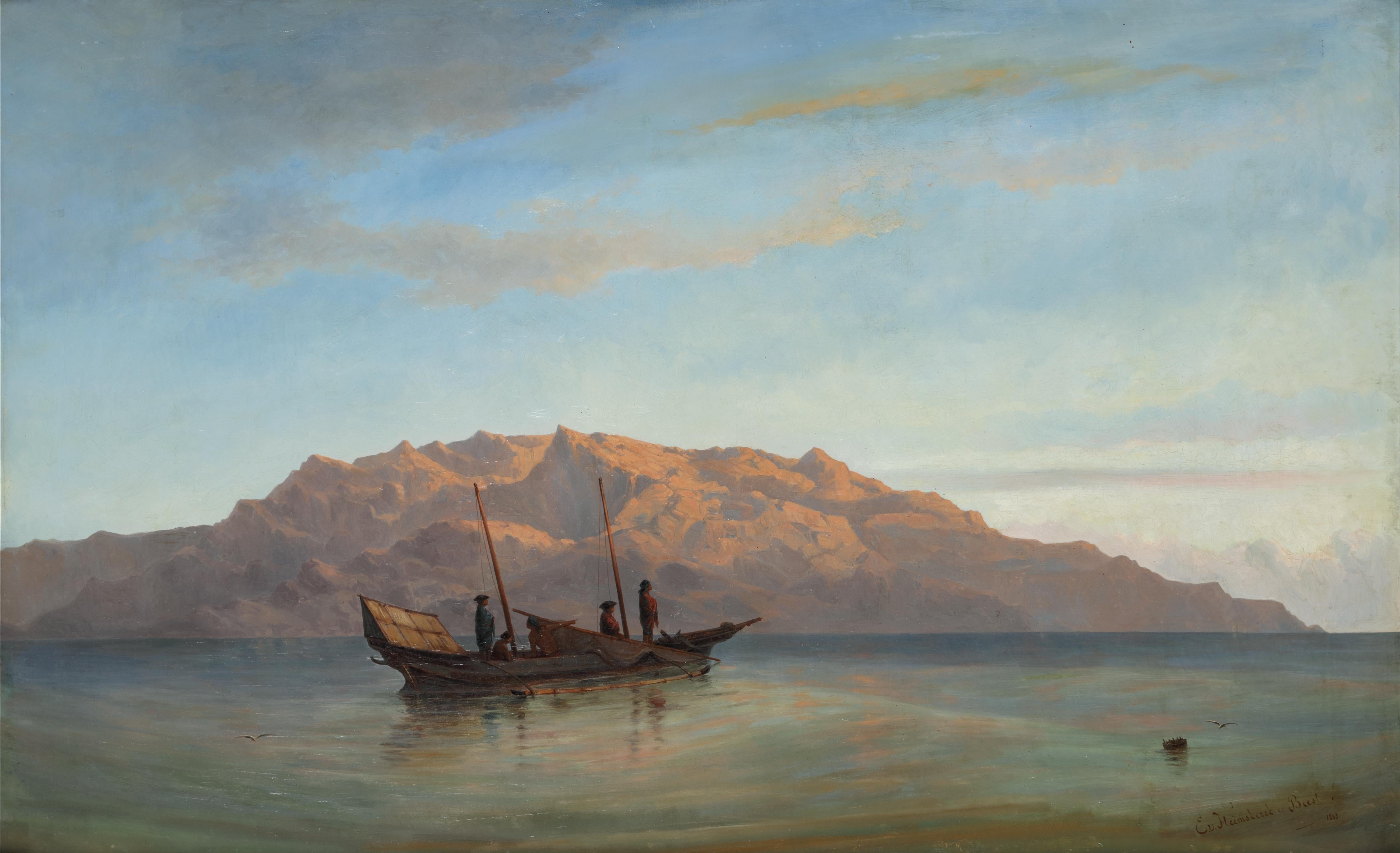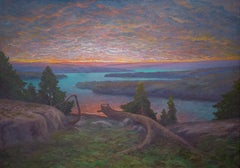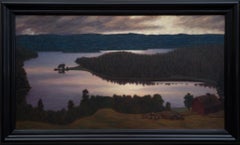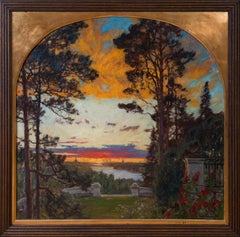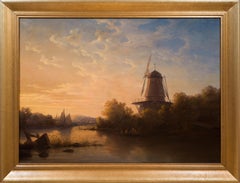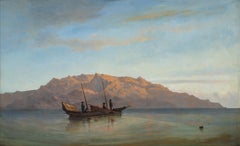Items Similar to Sunset by Hilding Werner (1925) – Formerly Owner Sven-Göran “Svennis” Eriksson
Video Loading
Want more images or videos?
Request additional images or videos from the seller
1 of 14
Hilding WernerSunset by Hilding Werner (1925) – Formerly Owner Sven-Göran “Svennis” Eriksson1925
1925
$16,445.12
£12,501.04
€13,900
CA$23,111.16
A$25,133.91
CHF 13,241.10
MX$305,256.05
NOK 166,467.42
SEK 156,049.76
DKK 106,444.36
About the Item
Sunset (1925) depicts a serene lake in Värmland at the close of day, suffused with the golden light of dusk. In this composition, Werner captures one of his signature motifs: a broad, tranquil lake encircled by dense forested ridges and distant blue-tinged hills beneath a luminous twilight sky. Clouds gilded by the setting sun are mirrored in the still water, their reflections amplifying the scene’s radiant glow. A dark treeline in silhouette stretches along the horizon, its gentle ridge line framing the brilliance of the sky., The atmosphere is one of hushed tranquility and stämning (mood) nature presented in its most sublime and unspoiled aspect, entirely devoid of human figures, thereby emphasizing the landscape’s grandeur and spiritual resonance. Werner’s delicate handling of light and color is evident in the soft gradations of warm amber and cool blue hues, which convey not only the visual impression of sunset but also an emotional undertone of calm reflection.
The Artist
Hilding Werner was a Swedish landscape painter known for his romantic visions of the Värmland countryside. Active in the early 20th century, Werner played an important role in Swedish landscape painting of that era, as part of the late National Romantic movement. Born in the village of Kårud, Värmland in 1880, he maintained a lifelong connection to the region’s lakes and forests. Werner received his formal art education in Stockholm, enrolling in Richard Bergh’s progressive art school around 1900. Under Bergh – a leading figure of Swedish national romantic art – and other instructors like Anders Zorn and Nils Kreuger, Werner was encouraged to seek inspiration in Nordic nature and to internalize and “poeticize” its forms with feeling. This training instilled in him a deep appreciation for capturing the atmospheric mood of the Swedish landscape, a hallmark of Scandinavian painting at the time.
After his studies, Werner returned permanently to his native Värmland in 1907, establishing a studio in the rural village of Stömne. Back amid the wild forests and mirror-like lakes of western Sweden, he discovered the motifs that would define his oeuvre: panoramic vistas of vast lakes framed by woods and distant hills at dawn or dusk, as well as silent winter forests cloaked in snow. These subjects, often observed at twilight, allowed Werner to express what he called his “love and worship of Swedish nature.” He became essentially a romantic mood painter of his homeland, dedicated to portraying nature in tranquil, sublime moods. His landscapes typically omit human presence, focusing on nature’s grandeur and evoking a quasi-spiritual reverence for the land. In this respect, Werner’s art carried forward the 19th-century National Romantic ideal of finding national identity and solace in the Nordic wilderness.
Werner’s career in Värmland brought him into contact with the Rackstad colony (Racken Group) near Lake Racken outside Arvika – an influential artists’ community led by Gustaf Fjaestad, which was devoted to depicting the unspoiled Nordic landscape with spiritual and symbolic overtones. Werner shared with Fjaestad and his circle the conviction that nature harbored a spiritual essence best conveyed through art. Like those artists, he sought to infuse his landscapes with an almost mystical atmosphere, interpreting the scenery not just realistically but symbolically to communicate emotional or spiritual truths. Though friendly with Fjaestad, Werner remained something of a regional lone wolf; he never formally joined the Rackstad colony, preferring to work independently in his secluded studio while still drawing inspiration from their ideals. He later became one of the initiators of the Värmland Artists’ Association, further cementing his role as a key figure in the region’s art scene.
Stylistically, Hilding Werner’s work bridges late Scandinavian National Romanticism and early 20th-century Symbolism. His paintings are marked by a lyrical, often melancholy serenity and a deep patriotic love of the Swedish landscape, combined with a refined handling of light and color that reveals the influence of French Impressionism and Post-Impressionism. Werner was influenced by his mentor Richard Bergh and by contemporaries like Fjaestad, as well as by the earlier Swedish landscape master Otto Hesselbom, whose expansive horizons and twilight skies he often emulated. However, Werner’s technique was distinctly his own: he applied paint with a soft, skillful brushwork and nuanced color modulation that lent his canvases a particular sophistication and “fresh tidiness,” setting them apart within the Nordic landscape tradition. Critics have noted the saturated yet harmonious palettes in his scenes – for example, the use of violet and blue tones to impart a wistful, twilight mood – and the gentle, rounded forms that imbue his compositions with a dreamy, almost pantheistic lyricism.
Throughout his life, Werner remained profoundly devoted to the Värmland landscape. He seldom traveled abroad (aside from a brief study trip to the Netherlands in 1905), choosing instead to draw lifelong inspiration from Sweden’s own natural vistas. This steadfast focus on his native scenery was in line with a broader Scandinavian tradition of celebrating national identity through nature’s grandeur. Many of Werner’s works were acquired by collectors during his lifetime, attesting to their appeal. His legacy has since been honored with institutional recognition: the Värmlands Museum in Karlstad holds a collection of his art and mounted major retrospective exhibitions of his work in the 1950s and again in 2015. Today, Hilding Werner is esteemed as an important interpreter of the Nordic landscape – a painter who authentically captured the soul of Värmland with a reverent eye and masterful technique.
Title: Solnedgång (Sunset) 1925
oil on canvas
signed and dated 1925.
unframed 48 × 78 cm (18.9 × 30.7 in)
framed 58 × 88 cm (22.8 × 34.6 in)
Condition:
Professionally restored in 2025 by Sonia Leon.
Provenance:
Formerly in the Collection of Sven-Göran “Svennis” Eriksson, the internationally renowned Swedish football coach. (Certificate from the Eriksson family is included)
- Creator:Hilding Werner (1880 - 1944, Swedish)
- Creation Year:1925
- Dimensions:Height: 18.9 in (48 cm)Width: 30.71 in (78 cm)
- Medium:
- Movement & Style:
- Period:
- Condition:Restoration 2025 by professional art conservator in Stockholm, the painting is in a very good condition with bright and clear colors. A new hand-made frame by Christer Björkman is included.
- Gallery Location:Stockholm, SE
- Reference Number:1stDibs: LU1445217146342
Hilding Werner (1880–1944) was a Swedish painter whose name is closely tied to the landscapes of Värmland. His lyrical depictions of lakes, forests, and skies at dawn or dusk capture the poetry of nature with quiet intensity, earning him a place among the most distinctive landscape painters of his generation. Werner was born in Kårud, Värmland, and grew up surrounded by the wilderness that would remain the central motif of his art. After secondary school in Karlstad, he moved to Stockholm in 1899 to pursue artistic training. He studied at Caleb Althin’s painting school and later at the Artists’ Association School (Konstnärsförbundet) under Richard Bergh. During this time, Werner also supported himself as a caricaturist for the satirical magazine Nya Nisse.
Influenced by Bergh and introduced to a circle of progressive artists through his cousin Bror Lindh, Werner absorbed ideas about painting directly from nature and imbuing landscapes with atmosphere and emotion. He briefly traveled to the Netherlands in 1905 but soon returned to Sweden, drawn back by the serenity of his native Värmland.
In 1907 Werner settled permanently in Stömne, on the shores of Hammartjärnet. There, he transformed a small lakeside cottage into his studio and devoted himself almost entirely to painting the surrounding countryside. His work focused on the subtle shifts of light across water, the silhouettes of pines against glowing skies, and the quiet stillness of snowy forests. Werner preferred transitional times of day—sunset, twilight, and pale winter afternoons—when nature seemed most contemplative. His brushwork, while rooted in careful observation, revealed a refined sensitivity to color and mood, creating landscapes at once intimate and expansive.
Werner’s career brought him into contact with several key figures of Swedish art. He was a friend of Gustaf Fjaestad, central to the Rackstad artists’ colony, and in 1912 visited Otto Hesselbom, whose grand vistas of lakes and skies inspired Werner to embrace more panoramic compositions. Yet his style remained distinct—gentler, more lyrical, and imbued with personal reflection.
Though he exhibited regularly with artists’ associations and local societies, Werner never sought the limelight and refrained from holding a solo exhibition during his lifetime. His modesty meant that wider recognition came only after his death, with a memorial exhibition at Värmlands Museum in 1946.
Today, Hilding Werner is celebrated as a painter who gave voice to the spirit of Värmland. His works are represented in museum and private collections, admired for their serene beauty and atmospheric depth. Collectors value not only his mastery of mood and light but also the authenticity of his vision: a life lived in harmony with the landscape he painted. His canvases remain timeless invitations into the quiet poetry of Sweden’s natural world.
About the Seller
5.0
Platinum Seller
Premium sellers with a 4.7+ rating and 24-hour response times
Established in 2020
1stDibs seller since 2020
208 sales on 1stDibs
Typical response time: <1 hour
Associations
International Confederation of Art and Antique Dealers' Associations
- ShippingRetrieving quote...Shipping from: Stockholm, Sweden
- Return Policy
Authenticity Guarantee
In the unlikely event there’s an issue with an item’s authenticity, contact us within 1 year for a full refund. DetailsMoney-Back Guarantee
If your item is not as described, is damaged in transit, or does not arrive, contact us within 7 days for a full refund. Details24-Hour Cancellation
You have a 24-hour grace period in which to reconsider your purchase, with no questions asked.Vetted Professional Sellers
Our world-class sellers must adhere to strict standards for service and quality, maintaining the integrity of our listings.Price-Match Guarantee
If you find that a seller listed the same item for a lower price elsewhere, we’ll match it.Trusted Global Delivery
Our best-in-class carrier network provides specialized shipping options worldwide, including custom delivery.More From This Seller
View AllA Scandinavian Landscape View by Swedish Artist Oscar Lycke, Large Size Painting
Located in Stockholm, SE
Oscar Lycke was a Swedish artist from Sundsvall. He is best known for his impressive colourful landscape paintings in a national romantic and realism styl...
Category
1920s Romantic Landscape Paintings
Materials
Canvas, Oil
$3,274 Sale Price
25% Off
Hilding Werner (1880-1944) - Moonlight Over Krokvattnet (near Glafsfjorden)
Located in Stockholm, SE
Hilding Werner (1880-1944) was a Swedish artist known for his portraits, romantic landscape paintings of Värmland, and caricature drawings. We are privi...
Category
Early 20th Century Romantic Landscape Paintings
Materials
Canvas, Oil
A view of Stockholm from an imaginary terrace, 1906
Located in Stockholm, SE
Gottfrid Kallstenius (Västervik 1861–1943 Storängen, Stockholm)
A view of Stockholm from an imaginary terrace, 1906
Signed and dated “G. Kallstenius -06”
Arched top
Oil on canvas
u...
Category
Early 1900s Romantic Landscape Paintings
Materials
Canvas, Oil
Stilla sommarkväll (Still Summer Evening) 1851
Located in Stockholm, SE
Stilla sommarkväll (1851) by Adolf Julius Berg captures a tranquil summer evening by the water, suffused with the golden glow of sunset. In the foreground, two small boats drift on glassy, reflective waters – in one, a man stands with a fishing rod in hand, patiently angling as the day fades. A gentle breeze appears to carry a few diminutive sailboats across the distant bay, their sails illuminated by the last warm light. On the shoreline stands an old windmill, its silhouette etched against the radiant twilight sky. The overall composition exudes calm and harmony, evoking the profound stillness of a Nordic summer nightfall.
The alla prima handling of light and color – from the lambent rose-tinted clouds to the lustrous reflections in the water – showcases Berg’s skill in rendering atmosphere and nuanced illumination. In its poetic serenity, Still Summer Evening stands as a superb example of Berg’s romantic landscape artistry, inviting the viewer into a moment of idyllic peace.
In both subject and style, this painting is emblematic of Adolf J. Berg’s oeuvre. The coastal setting with a windmill and tranquil waters suggests a locale in southern Sweden – likely inspired by the archipelagic shores of Berg’s native Blekinge or a similar Swedish seaside landscape. Berg often painted scenes from Blekinge and other picturesque Swedish locales, and he favored twilight or moonlit atmospheres that imbue the scenery with a mellow, contemplative light. The warm, low-angled sunlight in Stilla sommarkväll, reflecting off calm water and silhouetting rustic structures, is typical of his fascination with dawn and dusk effects. In the harmonious balance of land, water, and sky, one can sense the influence of Berg’s early mentor, the venerable Romantic landscapist Carl Johan Fahlcrantz, whose tradition of lyrical, sunset-lit vistas is carried on here. Every element – from the fishermen quietly tending their evening catch to the distant sails gliding home – contributes to the painting’s atmosphere of gentle reverie, evoking the timeless charm of a Swedish summer night.
Adolf Julius Berg (1820–1876) was a Swedish landscape painter celebrated for his atmospheric portrayals of the Nordic countryside. Born in the coastal city of Karlskrona, Berg developed an early affinity for marine and riverside scenes. His artistic approach was shaped initially by the poetic realism of Carl Johan Fahlcrantz, and later by the dramatic naturalism of Marcus Larson...
Category
1850s Romantic Landscape Paintings
Materials
Canvas, Oil
View from Månberget, Källvik (1912)
Located in Stockholm, SE
The view from Månberget at sunset, as captured by Gottfrid Kallstenius in this 1912 oil painting, displays a warm golden light over Djupsundet, framed by the silhouette of a gnarled ...
Category
1910s Romantic Landscape Paintings
Materials
Canvas, Oil
Three Women by the Shore, Preparing to Bathe in the Morning Light
By August Hagborg
Located in Stockholm, SE
This luminous and finely executed painting by August Hagborg captures three nude women preparing to bathe at the edge of a still, tree-lined body of water. One figure is seated on a ...
Category
Early 20th Century Romantic Figurative Paintings
Materials
Canvas, Oil
You May Also Like
Evening prayers by fishermen under the high coast of Celebes
Located in Amsterdam, NL
Jacob Eduard Van Heemskerck Van Beest (1828-1894)
“Avondgebed; Maleidische tripang visschers onder de hoge kust van Celebes” (Ev...
Category
19th Century Romantic Landscape Paintings
Materials
Canvas, Oil
Courtship in the Forest French Romantic School XIX century oil on canvas
Located in Sitges, Barcelona
Title: *Courtship in the Forest*
Author: French Romantic School
Technique: Oil on canvas
Support: Canvas mounted on a stretcher
Unframed dimensions: 11.4 x 7.9 inches
Frame...
Category
Late 19th Century Romantic Figurative Paintings
Materials
Canvas, Oil
"Outside The Tavern", 19th Century Oil on Canvas by Joaquín Domínguez Bécquer
By Joaquín Domínguez Bécquer
Located in Madrid, ES
JOAQUÍN DOMÍNGUEZ BÉCQUER
Spanish, 1817 - 1879
OUTSIDE THE TAVERN
signed, located & dated "Joaq. D. Becquer. Sevilla 1849." (lower right)
oil...
Category
1840s Romantic Figurative Paintings
Materials
Canvas, Oil
"Courtship", Late 19th Century Oil on Canvas by Sapnish Artist M. Alonso Pérez
By Mariano Alonso Pérez
Located in Madrid, ES
MARIANO ALONSO PÉREZ
Spanish, 1857 - 1930
COURTSHIP
signed "Alonso Pérez" (lower left)
oil on canvas
23 x 12-1/8 inches (58 x 30.7 cm.)
framed: 28...
Category
1890s Romantic Figurative Paintings
Materials
Canvas, Oil
"Riders Passing by a Tavern", 19th Century Oil on Canvas by Joaq. D. Bécquer
By Joaquín Domínguez Bécquer
Located in Madrid, ES
JOAQUÍN DOMÍNGUEZ BÉCQUER
Spanish, 1817 - 1879
RIDERS PASSING BY A TAVERN
signed, located & dated "Joaq. D. Becquer. Sevilla, 1847." (lower l...
Category
1840s Romantic Figurative Paintings
Materials
Canvas, Oil
"Washerwomen", 19th Century Spanish School Oil on Canvas of Washerwomen at Work
Located in Madrid, ES
SPANISH SCHOOL, 19th CENTURY
ARTIST UNKNOWN
oil on canvas
10-1/2 x 7-5/8 inches (26.5 x 19.3 cm.)
framed: 15-1/2 x 12-1/2 inches (39 x 31.5 cm.)
PROVENANCE
Spanish Collector, Madrid...
Category
1890s Romantic Figurative Paintings
Materials
Canvas, Oil
